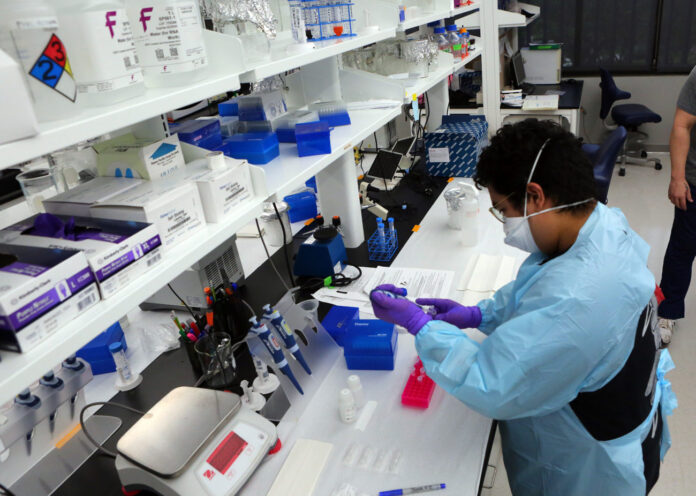Even as a shortage of testing capacity bedevils Cameron County’s efforts to get the COVID-19 outbreak under control, some types of rapid tests available out there are essentially worthless when it comes to telling whether someone actually has the virus.
That’s according to Dr. Joseph McCormick, renowned epidemiologist and founder of the UTHealth School of Public Health in Brownsville, who said the rapid antibody and antigen tests being offered at many clinics and pharmacies aren’t good at detecting the virus. It gives a false sense of security and is potentially dangerous, since people who think they’ve tested negative for COVID-19 could still be carrying it and infecting others, he said.
For all practical purposes, the only reliable COVID-19 test is the PCR test. PCR stands for polymerase chain reaction. When someone sticks a swab up your nose at a drive-through testing site and then you have to wait several days for the results, that’s a PCR test, and it’s highly accurate.
“ It’s called actually a reverse transcriptase PCR,” McCormick said. “What you’re doing is making DNA copies of the viral RNA. This is an RNA virus, not a DNA. But using these reverse transcriptase enzymes you can make copies. That’s the whole principal of the PCR. … The process is to make as many copies as you can to increase the amount of the DNA copies, which gives you a much higher chance of actually detecting the virus.
The method is a much more sensitive way to detect the virus than the other types of tests, he said.
“ That’s what I tell everybody,” McCormick said. “That’s what they need to get. Anything less than that is just not going to be up to the mark. If you want to know for sure if you’re infected, you need to get a real test.”
Unfortunately, getting the real thing can be difficult in light of the county’s overstressed testing capacity, and getting the results back can take a long time because of the backlog at labs.
McCormick said rapid antigen tests are similar to flu tests in that they look for proteins associated with the virus, which makes them “massively less sensitive” compared to a PCR test, which detects the virus RNA genome. As for antibody tests, for those who seek them out because they think they’ve been exposed to an infected person, the result is almost always going to be going to be negative, since antibodies only appear in the later stages of infection.
“ Even if it’s positive it doesn’t mean anything in terms of whether they’re infected or whether they can spread the virus, particularly if it’s early on in the infection,” McCormick said. “It’s false security.”
In addition to the full-fledged PCR test, a small number of “PCR-type” tests are available through some health care providers and take about 45 minutes to an hour to produce results, he said. They’re not cheap, and less sensitive than a standard PCR test, though more accurate than the antigen or antibody tests for detecting the virus, McCormick said.
As for a vaccine, innumerable trials are taking place around the world, he said. Many of the vaccines being tested are similar, and some are more promising than others at this stage. Among those leading the pack is Oxford University in partnership with the multinational biopharmaceutical company AstraZeneca. Also, the federal government and the Gates Foundation have invested heavily in an RNA vaccine — there’s never been an RNA vaccine — being developed by the U.S. biotech firm Moderna, McCormick said.
Pfizer is working on a vaccine, as is Sanofi, a French pharmaceutical company that is the world’s largest maker of flu vaccines, he said. Vaccines are also being tested in China, Germany and elsewhere.
“ There are over 100 vaccine candidates out there, and so we’ll just have to see,” McCormick said.
The bigger companies are taking a big financial risk by ramping up vaccine manufacture even before testing is complete, partly because of confidence in the vaccines but also because of the urgency of being able to supply huge amounts of vaccine quickly as the spread of COVID-19 accelerates in hot spots around the world, including the United States, which leads all other nations in the number of cases and deaths, he said. Texas has among the highest number of total cases and deaths among U.S. states.
“ People talk about herd immunity,” McCormick said. “That’s the way you get herd immunity, is to vaccinate people. They’re going to have to reach at least 70 to 80 percent of the population in order to get herd immunity. If you take 7 billion people or whatever it is on the planet, that’s like 5 billion people that have to get vaccinated. That’s a tall order.”
McCormick said he plans to get vaccinated at the earliest opportunity and noted that, like flu vaccines, even if it’s less than 100 percent effective, a person will still be much less likely to contract COVID-19 after being vaccinated.
“ Even if it’s not a perfect vaccine, that’s better than no vaccine for sure,” he said.





